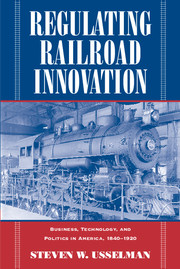Book contents
- Frontmatter
- Contents
- List of Illustrations
- Preface and Acknowledgments
- Introduction
- Part I ASSEMBLING THE MACHINE, 1840–1876
- Part II RUNNING THE MACHINE, 1876–1904
- 4 Patent Remedies: Politics, Jurisprudence, and Procedure
- 5 Mastering Technology, Channeling Change
- 6 Standardizing Steel Rails: Engineered Innovation
- 7 Engineering Enshrined
- Part III FRICTION IN THE MACHINE, 1904–1920
- Epilogue: The Enduring Challenge of Innovation
- Index
6 - Standardizing Steel Rails: Engineered Innovation
from Part II - RUNNING THE MACHINE, 1876–1904
Published online by Cambridge University Press: 12 August 2009
- Frontmatter
- Contents
- List of Illustrations
- Preface and Acknowledgments
- Introduction
- Part I ASSEMBLING THE MACHINE, 1840–1876
- Part II RUNNING THE MACHINE, 1876–1904
- 4 Patent Remedies: Politics, Jurisprudence, and Procedure
- 5 Mastering Technology, Channeling Change
- 6 Standardizing Steel Rails: Engineered Innovation
- 7 Engineering Enshrined
- Part III FRICTION IN THE MACHINE, 1904–1920
- Epilogue: The Enduring Challenge of Innovation
- Index
Summary
Perhaps no area of technology better reflected the turn toward engineered innovation and the process of negotiated improvement through technical specifications than the sustained efforts by railroads to obtain heavier and more durable steel rails. According to the systematic assessment of economic historian Albert Fishlow, changes in rails contributed a larger share to railroad productivity improvements between 1870 and 1910 than any other technology. By the end of that period, he concludes, railroads were saving an estimated $479 million per year by using the stronger and more durable steel rails then available in place of iron rails of 1870 quality and price. Some of those savings accrued directly from the superior capacity of steel to resist wear. A section of track laid with steel rails lasted significantly longer for less cost than a similarly used section laid with iron. But most of the benefits identified by Fishlow flowed indirectly from changes associated with the increased strength of the rail. Steel rails could, quite simply, support heavier locomotives and cars without breaking, and trains made up of such equipment carried passengers and freight at substantially lower costs per mile than their lighter predecessors. Innovation in rail technology thus was a great facilitator. It eliminated a potentially debilitating constraint and paved the way, so to speak, for a mode of operations made possible by a host of additional innovations in management and machinery.
- Type
- Chapter
- Information
- Regulating Railroad InnovationBusiness, Technology, and Politics in America, 1840–1920, pp. 215 - 241Publisher: Cambridge University PressPrint publication year: 2002

